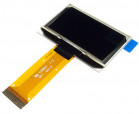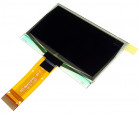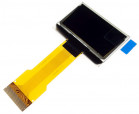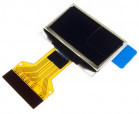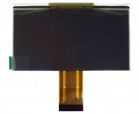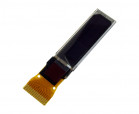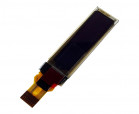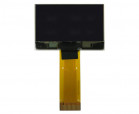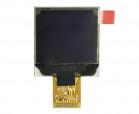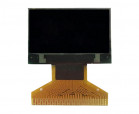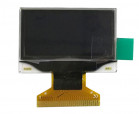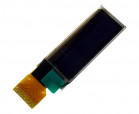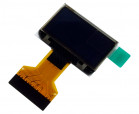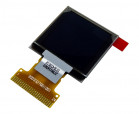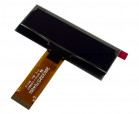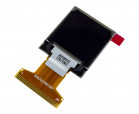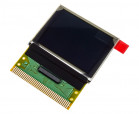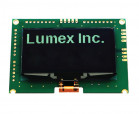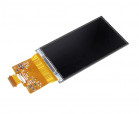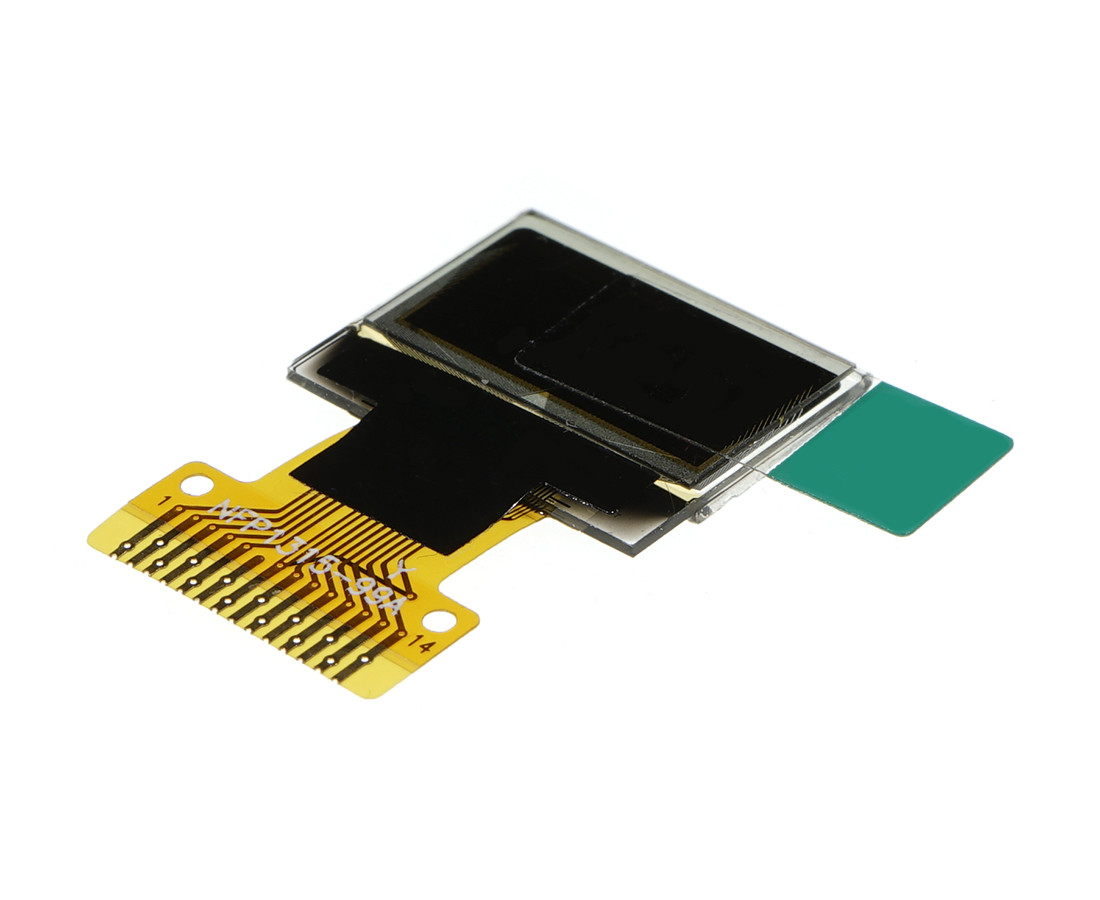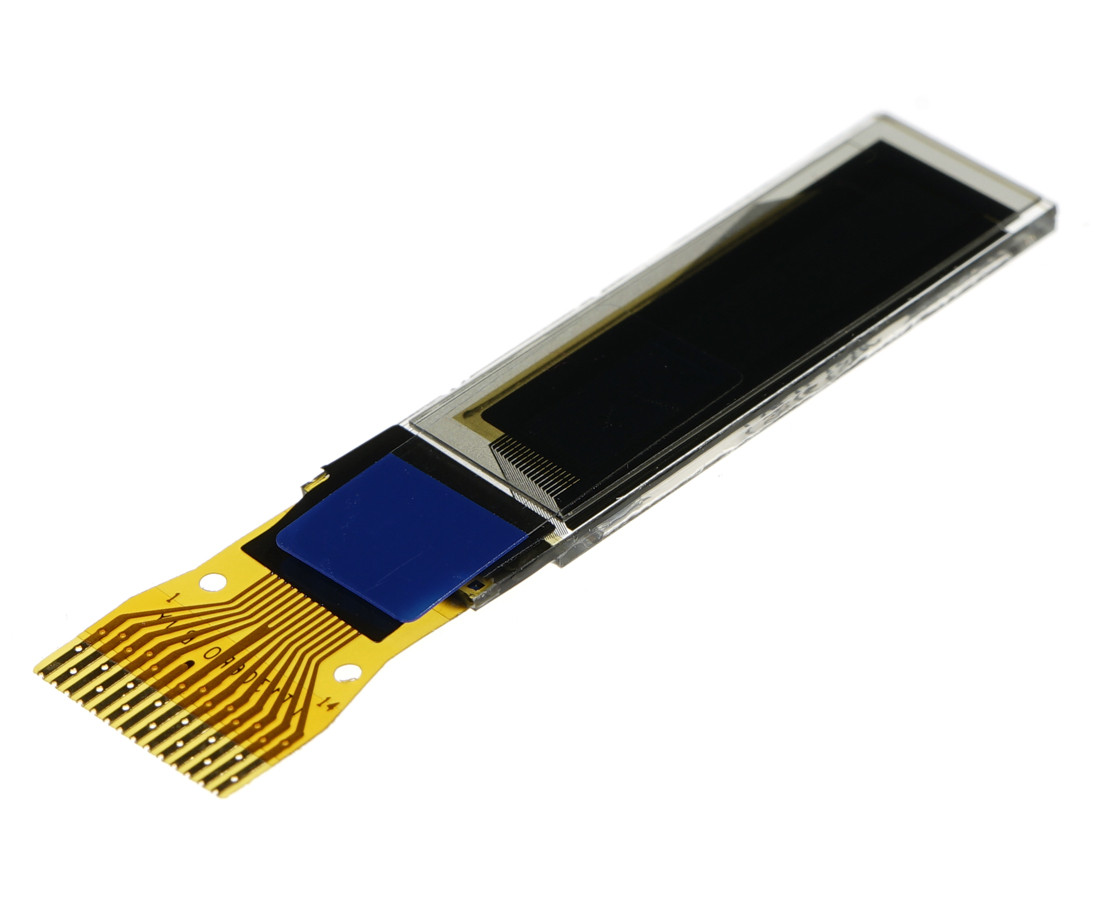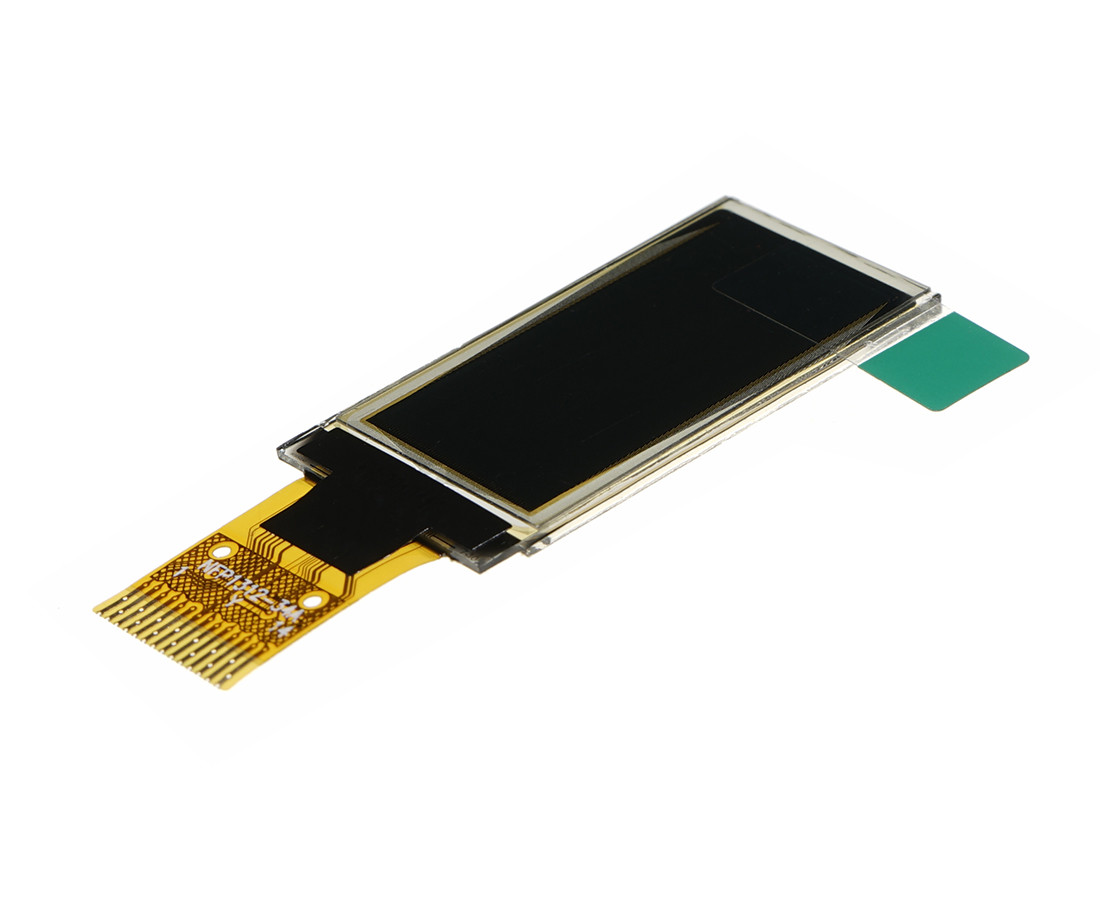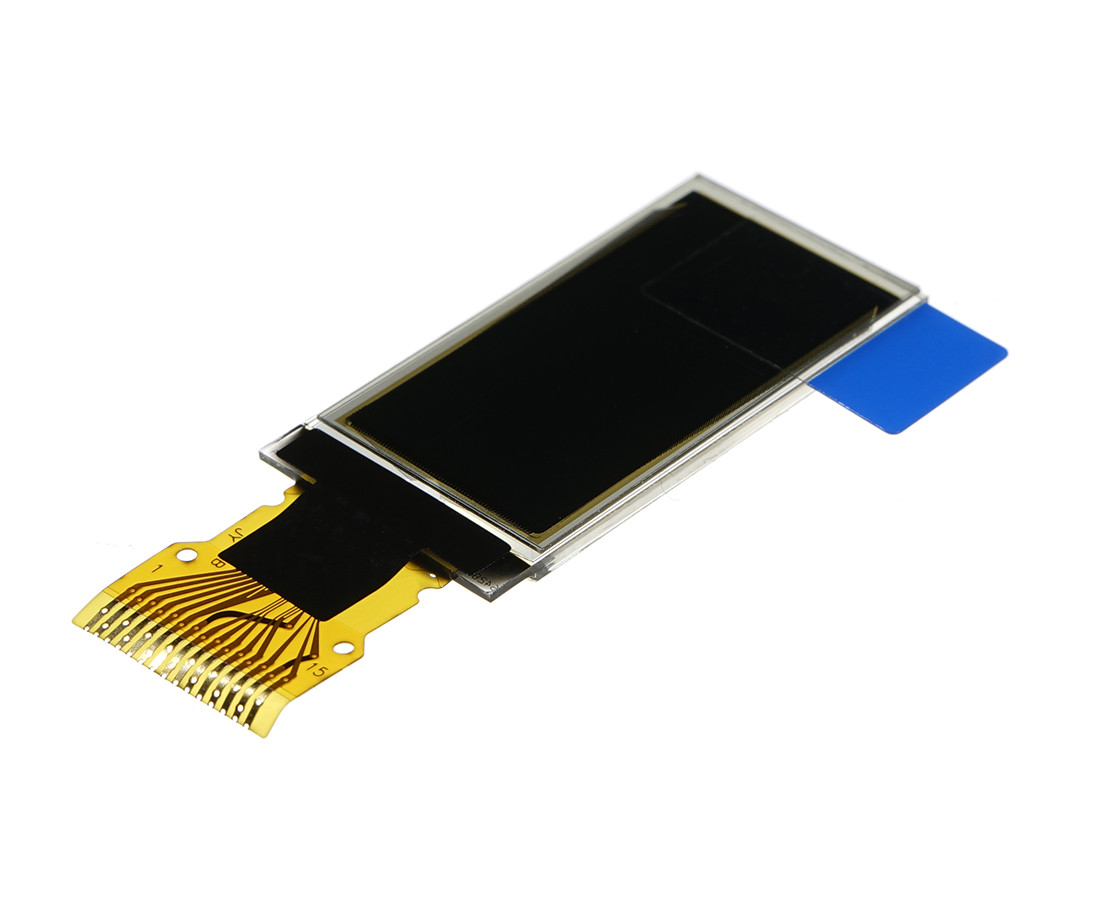OLED Displays (results: 66)
| Product | Cart |
Size
|
Window size
|
Parameters
|
Resolution
|
Supply voltage
|
Interface
|
Operating temperature (range)
|
Backlight colour
|
Number of colours
|
Usage
|
||||||||||||
|---|---|---|---|---|---|---|---|---|---|---|---|---|---|---|---|---|---|---|---|---|---|---|---|
|
DEP128064S-W Display Elektronik
OLED graphic display 128x64pkt; diagonal 2,4"; white; 8bit MCU, I2C, SPI Dimensions: 60,5x37x2,15mm; active area: 55,01x27,49mm; operating voltage: 2,8-3,3V; operating temperature: -40°C ~ 80°C
|
|||||||||||||||||||||||
|
Manufacturer:
DISPLAY ELEKTRONIK Manufacturer part number: DEP 128064S-W RoHS Case style: Rys.DEP128064S-W |
In stock:
5 pcs. |
||||||||||||||||||||||
|
Packaging: 5 Quantity (multiple 1) |
60,5x37x2,15mm | 55,01x27,49mm | SSD1309Z Driver | 128x64 | 2,8V ~ 3,3V | 8bit MCU, I2C, SPI | -40°C ~ 80°C | White | ||||||||||||||
|
Manufacturer:
DISPLAY ELEKTRONIK Manufacturer part number: DEP128064S-W Case style: Rys.DEP128064S-W |
External warehouse:
48 pcs. |
||||||||||||||||||||||
|
Packaging: 1 Minimum order amount must exceed 20 Euro. |
60,5x37x2,15mm | 55,01x27,49mm | SSD1309Z Driver | 128x64 | 2,8V ~ 3,3V | 8bit MCU, I2C, SPI | -40°C ~ 80°C | White | ||||||||||||||
|
OLED graphic display 128x64pts; diagonal 1.54", white dimensions: 42.04x27.22x1.4mm; active area: 35.052x17.516mm;
|
|||||||||||||||||||||||
|
In stock:
1 pcs. |
|||||||||||||||||||||||
|
Packaging: 1 Quantity (multiple 1) |
42,04x27,22x1,4mm | 35.052x17.516mm | 128x64 | 4V | -40°C ~ 70°C | White | ||||||||||||||||
|
In stock:
5 pcs. |
|||||||||||||||||||||||
|
Packaging: 6 Quantity (multiple 1) |
42,04x27,22x1,4mm | 35.052x17.516mm | 128x64 | 4V | -40°C ~ 70°C | White | ||||||||||||||||
|
OLED graphic display 128x64pts; diagonal 2.42", white dimensions: 60.50x37.00x2.0mm; active area: 55.01x27.49mm;
|
|||||||||||||||||||||||
|
In stock:
1 pcs. |
|||||||||||||||||||||||
|
Packaging: 1 Quantity (multiple 1) |
60.50x37.00x2.0mm | 55.01x27.49mm | 128x64 | 4V | -40°C ~ 70°C | Yellow | ||||||||||||||||
|
In stock:
2 pcs. |
|||||||||||||||||||||||
|
Packaging: 3 Quantity (multiple 1) |
60.50x37.00x2.0mm | 55.01x27.49mm | 128x64 | 4V | -40°C ~ 70°C | Yellow | ||||||||||||||||
|
OLED graphic display 128x64pts; diagonal 1.3", blue dimensions: 34.5x23.0x1.4mm; active area: 29.42x14.7mm;
|
|||||||||||||||||||||||
|
In stock:
1 pcs. |
|||||||||||||||||||||||
|
Packaging: 1 Quantity (multiple 1) |
34.5x23.0x1.4mm | 29.42x14.7mm | 128x64 | 3,3V | -40°C ~ 70°C | White | ||||||||||||||||
|
In stock:
5 pcs. |
|||||||||||||||||||||||
|
Packaging: 6 Quantity (multiple 1) |
34.5x23.0x1.4mm | 29.42x14.7mm | 128x64 | 3,3V | -40°C ~ 70°C | White | ||||||||||||||||
|
OLED graphic display 128x64pts; diagonal 0.96", white dimensions: 24.74x16.9x1.42mm; active area: 21.74x10.86mm;
|
|||||||||||||||||||||||
|
Manufacturer:
PALM TECHNOLOGY Manufacturer part number: PROG1206W-A301 RoHS Case style: Rys.OLED12864PA-W |
In stock:
5 pcs. |
||||||||||||||||||||||
|
Packaging: 6 Quantity (multiple 1) |
24.74x16.9x1.42mm | 21.74x10.86mm | 128x64 | 3,3V | -40°C ~ 70°C | White | ||||||||||||||||
|
OLED graphic display 128x64pts; diagonal 2.70", white dimensions: 73.0x41.86x2.0mm; active area: 61.41x30.69mm;
|
|||||||||||||||||||||||
|
Manufacturer:
PALM TECHNOLOGY Manufacturer part number: PROG1206W-A201 Case style: Rys.OLED12864P-W |
In stock:
3 pcs. |
||||||||||||||||||||||
|
Packaging: 3 Quantity (multiple 1) |
73.0x41.86x2.0mm | 61.41x30.69mm | 128x64 | 3,3V | -40°C ~ 70°C | White | ||||||||||||||||
|
OLED9616-W
OLED graphic display 96x16pts; diagonal 0.69", white dimensions: 26.3x8.0x1.2mm; active area: 17.26x3.18 mm;
|
|||||||||||||||||||||||
|
Manufacturer:
import Manufacturer part number: PSP29105 RoHS Case style: Rys.OLED9616-W |
In stock:
5 pcs. |
||||||||||||||||||||||
|
Stock availableWhile the stock lasts
Packaging: 5 Quantity (multiple 1) |
26.3x8.0x1.2mm | 17.26x3.18 mm | 96x16 | 3,3V | -40°C ~ 70°C | White | ||||||||||||||||
|
OLED12832-W
OLED graphic display 128x32pts; diagonal 0.87", white dimensions: 39x8.7x1.22mm; active area: 21.356x5.324mm;
|
|||||||||||||||||||||||
|
Manufacturer:
import Manufacturer part number: PSP34201 RoHS Case style: Rys.OLED12832-W |
In stock:
5 pcs. |
||||||||||||||||||||||
|
Packaging: 5 Quantity (multiple 1) |
39x8.7x1.22mm | 21.356x5.324mm | 128x32 | 3,3V | -40°C ~ 70°C | White | ||||||||||||||||
|
OLED12864-1.54-W
OLED graphic display 128x64pts; diagonal 1.54", white dimensions: 42.04x27.22x1.41mm; active area: 35.052x17.516mm;
|
|||||||||||||||||||||||
|
Manufacturer:
import Manufacturer part number: ENH-OBG24P154A RoHS Case style: Rys.OLED12864-1.54-W |
In stock:
5 pcs. |
||||||||||||||||||||||
|
Packaging: 5 Quantity (multiple 1) |
42.04x27.22x1.41mm | 35.052x17.516mm | 128x64 | 3,3V | -40°C ~ 70°C | White | ||||||||||||||||
|
OLED9696-0.96-W
OLED graphic display 96x96pts; diagonal 0.96", white dimensions: 24x25.7x1.2mm; active area: 17.26x17.26mm;
|
|||||||||||||||||||||||
|
Manufacturer:
import Manufacturer part number: ENH-OB0960096B RoHS Case style: Rys.OLED9696-0.96-W |
In stock:
5 pcs. |
||||||||||||||||||||||
|
Stock availableWhile the stock lasts
Packaging: 5 Quantity (multiple 1) |
24x25.7x1.2mm | 17.26x17.26mm | 96x96 | 3,3V | -40°C ~ 70°C | White | ||||||||||||||||
|
OLED graphic display 128x64pts; diagonal 0.96", white dimensions: 26.7x19.26x1.41mm; active area: 21.744x10.864mm;
|
|||||||||||||||||||||||
|
Manufacturer:
import Manufacturer part number: ENH-OB0096008A RoHS Case style: Rys.OLED12864-0.96-W |
In stock:
3 pcs. |
||||||||||||||||||||||
|
Packaging: 5 Quantity (multiple 1) |
26.7x19.26x1.41mm | 21.744x10.864mm | 128x64 | 3,3V | -40°C ~ 70°C | White | ||||||||||||||||
|
OLED graphic display 128x64pts; diagonal 1.3", white dimensions: 34.5x23x1.427mm; active area: 29.42x14.7mm;
|
|||||||||||||||||||||||
|
Manufacturer:
import Manufacturer part number: ENH-OB0130005A RoHS Case style: Rys.OLED12864-1.3-W |
In stock:
5 pcs. |
||||||||||||||||||||||
|
Packaging: 5 Quantity (multiple 1) |
34.5x23x1.427mm | 29.42x14.7mm | 128x64 | 3,3V | -40°C ~ 70°C | White | ||||||||||||||||
|
OLED12832-W
OLED graphic display 128x32pts; diagonal 0.91", white dimensions:30.0x11.5x1.2mm; active area: 22.384x5.584mm;
|
|||||||||||||||||||||||
|
Manufacturer:
import Manufacturer part number: Case style: Rys.OLED12832-W-2 |
In stock:
2 pcs. |
||||||||||||||||||||||
|
Packaging: 5 Quantity (multiple 1) |
30.0x11.5x1.2mm | 22.384x5.584mm | 128x32 | 2,5V-5,5V | -30°C ~ 70°C | White | ||||||||||||||||
|
OLED12864-W
OLED graphic display 128x64pts; diagonal 0.96", white dimensions: 24.74x16.9x1.42mm; active area: 21.74x10.86mm;
|
|||||||||||||||||||||||
|
Manufacturer:
import Manufacturer part number: Case style: Rys.OLED12864-W |
In stock:
4 pcs. |
||||||||||||||||||||||
|
Packaging: 5 Quantity (multiple 1) |
24.74x16.9x1.42mm | 21.74x10.86mm | 128x32 | 3,5V | -40°C ~ 70°C | White | ||||||||||||||||
|
OLED9696-W
OLED graphic display 96x96pts; diagonal 1.1", white dimensions: 27x42.11x1.61mm; active area:20.14x20.14mm;
|
|||||||||||||||||||||||
|
Manufacturer:
import Manufacturer part number: Case style: Rys.OLED9696-W |
In stock:
5 pcs. |
||||||||||||||||||||||
|
Stock availableWhile the stock lasts
Packaging: 5 Quantity (multiple 1) |
27x42.11x1.61mm | 20.14x20.14mm | 96x96 | 3,5V | -40°C ~ 70°C | White | ||||||||||||||||
|
OLED12832-B
OLED graphic display 128x32pts; diagonal 2.23", blue dimensions: 62x60x2.027mm; active area: 55.02x13.1mm;
|
|||||||||||||||||||||||
|
Manufacturer:
import Manufacturer part number: Case style: Rys.OLED12832-B |
In stock:
1 pcs. |
||||||||||||||||||||||
|
Packaging: 3 Quantity (multiple 1) |
62x60x2.027mm | 55.02x13.1mm | 128x32 | 3,5V | -40°C ~ 70°C | Blue | ||||||||||||||||
|
OLED9696-RGB
OLED graphic display 96x96pts; diagonal 1.1", RGB 65k col dimensions: 33.8x43.7x1.41mm; active area:26.86x26.86mm;
|
|||||||||||||||||||||||
|
Manufacturer:
import Manufacturer part number: Case style: Rys.OLED9696-RGB |
In stock:
3 pcs. |
||||||||||||||||||||||
|
Stock availableWhile the stock lasts
Packaging: 3 Quantity (multiple 1) |
33.8x43.7x1.41mm | 26.86x26.86mm | 96x96 | 3,5V | 65000 | |||||||||||||||||
|
OLED12896-RGB
OLED graphic display 128x96pts; diagonal 1.29", RGB 265k & 65k col dimensions: 33.39x39.8x1.21mm; active area:26.279x19.708mm;
|
|||||||||||||||||||||||
|
Manufacturer:
import Manufacturer part number: Case style: Rys.OLED12896-RGB |
In stock:
3 pcs. |
||||||||||||||||||||||
|
Packaging: 3 Quantity (multiple 1) |
33.39x39.8x1.21mm | 26.279x19.708mm | 128x96 | 3,5V | 256000 | |||||||||||||||||
|
LOD-12864GP-W-UART
OLED graphic display 128x64pts white diagonal 2.42", UART dimensions: 75x52.7mm; viewing area: 57.01 x 29.90 mm;
|
|||||||||||||||||||||||
|
Manufacturer:
import Manufacturer part number: Case style: Rys.OLED.LOD-12864GP-W-UART |
In stock:
1 pcs. |
||||||||||||||||||||||
|
Packaging: 1 Quantity (multiple 1) |
75x52.7mm | 57.01x29.90 mm | 128x64 | 3,3V | UART | -40°C ~ 70°C | White | |||||||||||||||
|
LOD-12864GP-Y-UART
OLED graphic display 128x64pts yellow diagonal 2.42", UART dimensions: 75x52.7mm; viewing area: 57.01 x 29.90 mm;
|
|||||||||||||||||||||||
|
Manufacturer:
import Manufacturer part number: Case style: Rys.OLED.LOD-12864GP-Y-UART |
In stock:
1 pcs. |
||||||||||||||||||||||
|
Packaging: 1 Quantity (multiple 1) |
75x52.7mm | 57.01x29.90 mm | 128x64 | 3,3V | UART | -40°C ~ 70°C | Yellow | |||||||||||||||
|
LOD-12864GP-G-UART
OLED graphic display 128x64pts green diagonal 2.42", UART dimensions: 75x52.7mm; viewing area: 57.01 x 29.90 mm;
|
|||||||||||||||||||||||
|
Manufacturer:
import Manufacturer part number: Case style: Rys.OLED.LOD-12864GP-G-UART |
In stock:
1 pcs. |
||||||||||||||||||||||
|
Packaging: 1 Quantity (multiple 1) |
75x52.7mm | 57.01x29.90 mm | 128x64 | 3,3V | UART | -40°C ~ 70°C | Green | |||||||||||||||
|
LOD-12864GP-B-UART
OLED graphic display 128x64pts blue diagonal 2.42", UART dimensions: 75x52.7mm; viewing area: 57.01 x 29.90 mm;
|
|||||||||||||||||||||||
|
Manufacturer:
import Manufacturer part number: Case style: Rys.OLED.LOD-12864GP-B-UART |
In stock:
1 pcs. |
||||||||||||||||||||||
|
Packaging: 1 Quantity (multiple 1) |
75x52.7mm | 57.01x29.90 mm | 128x64 | 3,3V | UART | -40°C ~ 70°C | Blue | |||||||||||||||
|
OLED240400-RGB
OLED graphic display 240x400pts; diagonal 2.83", RGB dimensions: 40.72x69.56x1.01mm; active area: 36.72x61.20mm;
|
|||||||||||||||||||||||
|
Manufacturer:
Samsung Manufacturer part number: Case style: Rys.OLED240400-RGB |
In stock:
1 pcs. |
||||||||||||||||||||||
|
Stock availableWhile the stock lasts
Packaging: 1 Quantity (multiple 1) |
40.72x69.56x1.01mm | 36.72x61.20mm | 240x400 | 2,5V-3,3V | -20°C ~ 70°C | |||||||||||||||||
|
Manufacturer:
Samsung Manufacturer part number: Case style: Rys.OLED240400-RGB |
In stock:
1 pcs. |
||||||||||||||||||||||
|
Stock availableWhile the stock lasts
Packaging: 4 Quantity (multiple 1) |
40.72x69.56x1.01mm | 36.72x61.20mm | 240x400 | 2,5V-3,3V | -20°C ~ 70°C | |||||||||||||||||
|
DEP16201-Y
OLED character display 16x2pkt; yellow dimensions: 80x36x6.4mm; active area: 66.0x16.0mm;
|
|||||||||||||||||||||||
|
Manufacturer:
DISPLAY ELEKTRONIK Manufacturer part number: Case style: Rys.DEP16201-Y |
In stock:
10 pcs. |
||||||||||||||||||||||
|
Packaging: 10 Quantity (multiple 1) |
Yellow | |||||||||||||||||||||
|
Manufacturer:
DISPLAY ELEKTRONIK Manufacturer part number: DEP16201-Y Case style: Rys.DEP16201-Y |
External warehouse:
78 pcs. |
||||||||||||||||||||||
|
Packaging: 1 Minimum order amount must exceed 20 Euro. |
Yellow | |||||||||||||||||||||
|
DEP16202-Y
OLED character display 16x2pkt; yellow dimensions: 84x44x6.4mm; active area: 66.0x16.0mm;
|
|||||||||||||||||||||||
|
Manufacturer:
Displaytech Ltd Manufacturer part number: Case style: Rys.DEP16202-Y |
In stock:
10 pcs. |
||||||||||||||||||||||
|
Packaging: 10 Quantity (multiple 1) |
84x44x10mm | Sterownik HD44780 | Yellow | 2 | N/A | |||||||||||||||||
|
OLED12864W-MT
OLED graphic display 128x64pts; white dimensions: 60.74mmx37.86mmx2.15mm; active area: 53.74mmx28.68mm
|
|||||||||||||||||||||||
|
Manufacturer:
RAYSTAR Manufacturer part number: REX012864GWPP3N00000 RoHS Case style: Rys.OLED12864W-MT |
In stock:
5 pcs. |
||||||||||||||||||||||
|
Packaging: 6/19 Quantity (multiple 1) |
60.74mmx37.86mmx2.15mm | 53.74mmx28.68mm | 128x64 | 2,8V-3,3V | -40°C ~ 80°C | White | ||||||||||||||||
|
OLED.0.49-MONO-W
Monochrome OLED graphic display 64x32pts; 0,49inch; white; I2C Dimensions: 14,5x11,6x1,21mm; active area: 11,18x5,58mm; operating voltage: 1,65-3,3V; operating temperature: -40°C ~ 85°C
|
|||||||||||||||||||||||
|
Manufacturer:
import Manufacturer part number: Case style: Rys.OLED.0.49-MONO-W |
In stock:
44 pcs. |
||||||||||||||||||||||
|
Packaging: 10/50 Quantity (multiple 1) |
14,5x11,6x1,21mm | 11,18x5,58mm | 1306 Driver | 64x32 | 1,65V ~ 3,3V | I2C | -40°C ~ 85°C | White | ||||||||||||||
|
OLED.0,69-MONO-W
Monochrome OLED graphic display 96x16pts; 0,49inch; white; I2C Dimensions: 26,3x8x1,2mm; active area: 17,26x3,18mm; operating voltage: 1,65-3,3V; operating temperature: -40°C ~ 85°C
|
|||||||||||||||||||||||
|
Manufacturer:
import Manufacturer part number: Case style: Rys.OLED.0,69-MONO-W |
In stock:
49 pcs. |
||||||||||||||||||||||
|
Packaging: 10/50 Quantity (multiple 1) |
26,3x8x1,2mm | 17,26x3,18mm | 1306 Driver | 96x16 | 1,65V ~ 3,3V | I2C | -40°C ~ 85°C | White | ||||||||||||||
|
OLED.0.96-MONO-W-I2C
Monochrome OLED graphic display 64x128pts; 0,96 inch; white; I2C Dimensions: 14x28x1,22mm; active area: 10,86x21,74mm; operating voltage: 1,65-3,3V; operating temperature: -40°C ~ 70°C
|
|||||||||||||||||||||||
|
Manufacturer:
import Manufacturer part number: Case style: Rys.OLED.0.96-MONO-W-I2C |
In stock:
39 pcs. |
||||||||||||||||||||||
|
Packaging: 10/40 Quantity (multiple 1) |
14x28x1,22mm | 10,86x21,74mm | 1312 Driver | 64x128 | 1,65V ~ 3,3V | I2C | -40°C ~ 70°C | White | ||||||||||||||
|
OLED.0.96-MONO-W-SPI
Monochrome OLED graphic display 64x128pts; 0,96 inch; white; 4-wire SPI Dimensions: 14x28x1,22mm; active area: 10,86x21,74mm; operating voltage: 1,65-3,3V; operating temperature: -40°C ~ 70°C
|
|||||||||||||||||||||||
|
Manufacturer:
import Manufacturer part number: Case style: Rys.OLED.0.96-MONO-W-SPI |
In stock:
39 pcs. |
||||||||||||||||||||||
|
Packaging: 10/40 Quantity (multiple 1) |
14x28x1,22mm | 10,86x21,74mm | 1312 Driver | 64x128 | 1,65V ~ 3,3V | 4-wire SPI | -40°C ~ 70°C | White | ||||||||||||||
OLED Displays
OLED displays represent an innovative image display technology that is gaining tremendous popularity across various applications, from smartphones and portable devices to televisions and monitors. These screens are known for their exceptional image quality, making them a preferred choice for both casual users and professionals. An OLED screen is constructed using OLEDs (Organic Light Emitting Diodes), and the primary feature distinguishing it from other display technologies like LED, LCD, and PDP is that it does not require additional backlighting. This is because the diode itself emits light, rather than merely filtering white light from behind as in other technologies.
Construction of an OLED Display
OLED displays consist of pixels that contain three (red, green, blue) or four (the three mentioned earlier plus an additional white) diodes, also known as subpixels. The diode layer is applied in a process similar to inkjet printing onto a base plate. Additionally, an intermediate layer is added between the plate and emitter to enhance the efficiency and brightness of the screen.
In more detail, the individual layers are as follows:
- Substrate – transparent, usually a film or glass,
- Two conductive electrodes – a transparent anode (which must allow the emitted light to pass through), also known as the emitter, and a cathode, not necessarily transparent, also known as the conductor,
- Two organic layers – a conductive layer (organic n-type semiconductor) and an emission layer, which is an organic p-type semiconductor. This layer is responsible for emitting electromagnetic radiation in the visible spectrum of light.
OLED – A Display for Top-Notch Image Quality Enthusiasts
OLED displays guarantee the best image quality currently available. Due to their construction, they offer infinite contrast (since each pixel generates its own light), unmatched response time (the time a pixel takes to change its state – either lighting up or turning off. While other screens have a response time of 2-12 milliseconds, OLED displays only require 0.01 milliseconds). Additionally, OLED displays do not suffer from color degradation that is common in other types of screens, regardless of the angle at which the image is viewed. OLED screens also have the widest color gamut coverage, making them ideal for graphic designers. Furthermore, OLED displays are exceptionally thin, lightweight, and consume less power due to the absence of the need for additional backlighting.


